Shale: Composition, Formation, Uses, Types
Shale is a fine-grained clastic sedimentary rock characterized by its fissility, shale readily cleaves into thin, typically less than 1 centimeter thick, laminae. Shale primarily composed of clay minerals, along with minor constituents like quartz and calcite.
Shale is the most common sedimentary rock type, constituting approximately 70% of exposed sedimentary rock on Earth.
Shale is characterized by its laminated structure, with thin, parallel layers resulting from the alignment of clay minerals during deposition. The primary constituent of shale is clay minerals, such as illite, kaolinite, and smectite, along with varying proportions of quartz, feldspar, and organic matter. Its color can range from gray and black to brown and red, depending on mineral content.
Shale Key Features:
- Category: Clastic Sedimentary Rock
- Color: Primarily gray, but varies with composition (black=organic, red=iron, etc.)
- Texture: Fine-grained, laminated, fissile (easily splits)
- Grain Size: Clay and silt-sized, (<0.0625 mm)
- Mineral Composition: Mainly clay minerals (kaolinite, illite), quartz, calcite, trace minerals
- Hardness: Soft (Mohs 2-3)
- Depositional Environment: Quiet aquatic environments (marine shelves, lakes, floodplains)
 |
| Shale Rocks |
Shale Composition
Shales are fine-grained clastic sedimentary rocks primarily composed of clay minerals (50-70%), silt-sized quartz grains (20-30%), and minor amounts of calcite (~5%). Trace minerals like pyrite, mica, and feldspar are also present in small quantities. Additionally, some shales contain significant amounts of organic matter (up to 20%), particularly oil shales.
Clay Minerals
Shale is predominantly composed of clay minerals, These fine-grained (less than 0.002 mm) phyllosilicates play a crucial role in defining shale's key characteristics.
Kaolinite, illite, chlorite, and smectite are the most common, but their relative abundances vary based on factors like weathering and depositional environment.
Kaolinite, A common clay mineral formed by the chemical weathering of aluminum-rich rocks. It often dominates in mature shales due to its stability and resistance to further alteration.
Illite: Another ubiquitous non-expanding clay mineral arising from the alteration of other clay minerals (e.g., smectite) or volcanic ash. Its mixed-layer structure with additional cations (e.g., potassium) enhances its stability and contributes to shale's hardness.
Smectite: known for its expandable nature, Less prevalent in mature shales due to its susceptibility to alteration under elevated temperature and pressure. Its expandable nature can influence water content and swelling influences the porosity and permeability of shale formations through its capacity for volumetric changes in response to environmental conditions.
Quartz and Feldspar
Mainly monocrystalline quartz, derived from eroded igneous, metamorphic, or sedimentary rocks.
Quartz (10-20%): This ubiquitous mineral, silicon dioxide (SiO2), occurs mainly as detrital grains derived from pre-existing rocks. It contributes to the rock's hardness and stability.
Feldspars (1-6%): These aluminosilicate minerals, like plagioclase and orthoclase, add chemical diversity and influence weathering patterns. Their presence can also contribute to the rock's color and reactivity.
Carbonate Minerals
Carbonate Minerals (3-7%): Calcite (CaCO3) and dolomite (CaMgCO3) often occur as cementing minerals, binding other grains together. They can also form distinct limestone beds within the shale sequence, impacting its porosity and permeability.
Iron Oxides
Iron Oxides (1-3%): Hematite (Fe2O3) and pyrite (FeS2) influence the rock's color and chemical composition. Hematite imparts reddish hues, while pyrite can cause golden shimmer or yellowish weathering stains.
Organic Matter
Shale's organic matter is not monolithic, but rather a diverse ensemble of macromolecules. The dominant player, kerogen, constitutes over 90% of the organic content.
Types of Organic Matter
Kerogen
The dominant player, composing over 90% of shale's organic matter, kerogen is a complex macromolecular mixture derived from the decomposition of land and marine organisms. Its chemical composition reflects the source organisms and environmental conditions during deposition.
Bitumen
This soluble fraction of organic matter constitutes less than 10% of shale's organic content. Comprising oil, asphaltenes, and resins, bitumen offers valuable insights into the early stages of hydrocarbon generation and serves as a crucial indicator for resource exploration.
Compositional Variations
Shale composition is not static; it can vary significantly depending on several factors, including:
Depositional Environment: Shales deposited in marine environments might contain higher carbonate content compared to those formed in freshwater settings.
Source Rocks: The type and composition of eroded rocks that provide the sedimentary material can influence the final shale composition.
Diagenetic Processes: Chemical and physical alterations after deposition can modify the mineral assemblage and texture of the rock.
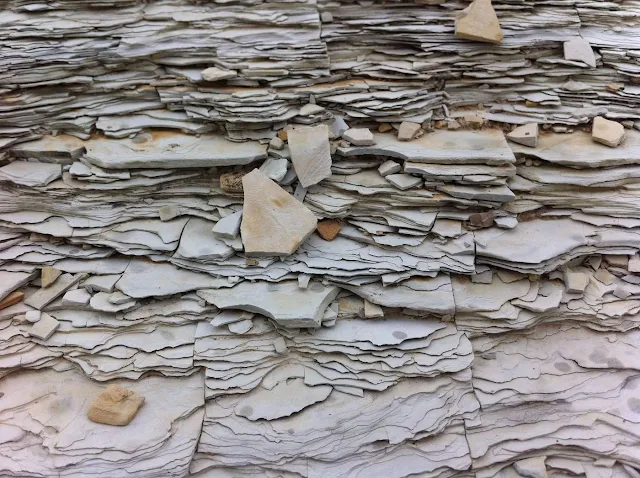 |
| Shale Outcrop |
Shale Formation
Shale formation is a geological process that results in the development of sedimentary rocks characterized by a fine-grained texture, laminated structure, and distinct mineralogical composition. This process unfolds over extended periods and involves several sequential stages, encompassing the accumulation, compaction, and lithification of sediments.
Shale formation typically begins in depositional environments characterized by low energy and minimal disturbance. These environments include lakes, swamps, deep-sea basins, and transitional marine areas. In these settings, fine-grained sediments such as clay and silt-sized particles settle out of suspension, forming layers on the basin floor.
Sediment Accumulation
The first stage in shale formation involves the gradual accumulation of fine-grained sediments. These sediments may originate from the weathering and erosion of pre-existing rocks or may be transported from distant sources by wind, water, or ice.
Compaction
As sediments continue to accumulate, the weight of overlying material exerts pressure on the lower layers. This pressure leads to compaction, reducing the pore spaces between sediment particles. The compaction process is crucial for the eventual lithification of the sediment into a solid rock.
Diagenesis
Diagenesis refers to the physical and chemical changes that occur within sediments as a result of burial. In the case of shale, diagenetic processes include the transformation of clay minerals and the maturation of organic matter. Illitization, the conversion of smectite to illite, is a common diagenetic alteration in shale.
Lithification
Lithification marks the transition from loose sediment to solid rock. The compacted and altered sediments undergo the process of lithification, binding the particles together and forming a cohesive rock mass.
Understanding the processes involved in shale formation provides valuable insights into Earth's geological history, past environmental conditions, and the potential economic significance of shale reservoirs as sources of hydrocarbons.
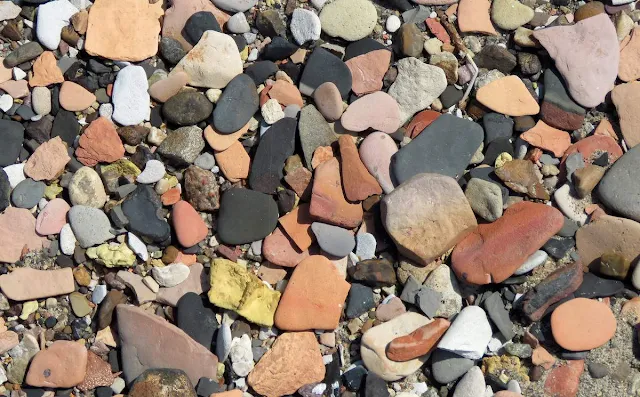 |
| Weathering shale at Fort Randall Dam, South Dakota Photo: Kelly Preheim |
Shale Properties
Shale, a fine-grained sedimentary rock, exhibits distinct characteristics and properties that are integral to its geological significance and potential economic uses. The key characteristics and properties of shale include:
Texture:
Grain Size: Shale typically features a fine-grained texture, with individual particles predominantly silt-sized (0.002-0.0625 mm) or clay-sized (less than 0.002 mm).
The smooth and compact feel often arises from the densely packed and interlocked nature of the fine particles.
Porosity and Permeability: Shale typically exhibits minimal porosity due to the dense packing of grains and relatively low cementation compared to other sedimentary rocks. This translates to low permeability, hindering the flow of fluids through the rock.
Porosity and permeability can further decrease with diagenetic processes like compaction and cementation.
Cementation and Matrix: Cementation in shale often involves minerals like silica, calcite, and dolomite, which precipitate in pore spaces, binding the particles together and contributing to the rock's overall strength.
The matrix of shale primarily comprises the fine-grained clastic particles (silt and clay) but can also include organic matter and authigenic minerals formed within the rock itself.
Fossils: Depending on the depositional environment, shale can contain diverse fossil assemblages. Common fossils include marine microorganisms, plants, invertebrates, and occasionally vertebrates.
The preservation of fossils in shale can be excellent due to the fine-grained matrix and potential anoxic conditions during deposition.
Weathering and Alteration: Shale is susceptible to various weathering processes:
Physical weathering: Mechanical processes like freeze-thaw and thermal expansion/contraction can cause shale to break into thin layers due to its inherent fissility.
Chemical weathering: Acidic rainwater can dissolve carbonate minerals in shale, altering its composition and creating distinctive surface features.
Biological weathering: Burrowing organisms and plant roots can contribute to physical breakdown and chemical alteration of shale.
Depositional Environment:
Shales form in various settings, broadly falling into marine, continental, and transitional environments.
Marine shales: Most common, form in deep, quiet waters like basins, shelves, or lagoons. Often rich in organic matter and dark-colored.
Continental shales: Deposited in freshwater environments like lakes, or floodplains. Less organic matter, various colors (red, green, gray).
Transitional shales: Mix of marine and continental influences, found in deltas or estuaries. Share characteristics of both types.
Special Features:
Fissility: Shale readily splits into thin sheets along its bedding planes due to the platy morphology of clay minerals and weak interlayer bonding. This characteristic is crucial for various applications, including roofing materials and slate pencils.
Organic matter content: Some shales are rich in organic matter, particularly kerogen, holding potential for hydrocarbon resources like oil and gas upon thermal maturation.
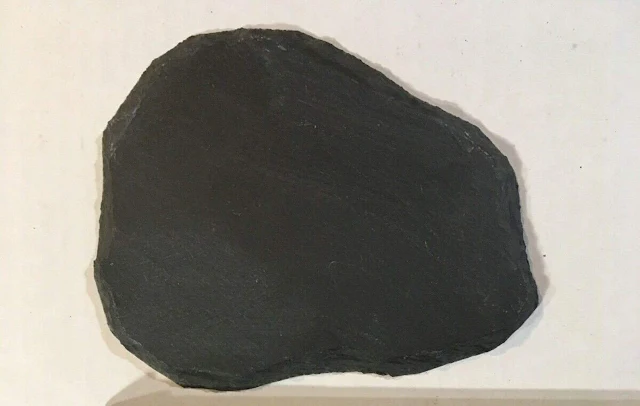 |
| Black shale - High organic content. |
Where is shale found
Shale is a sedimentary rock that is widely distributed around the world. It can be found in various geological settings and regions. Shale forms from the compaction of fine-grained mud and clay particles. Here are some common locations where shale is found:
Sedimentary Basins: Shale is often found in sedimentary basins, which are large depressions in the Earth's crust where sediments accumulate over time. Examples include the Appalachian Basin in the United States and the Paris Basin in France.
Continental Shelves: Shale deposits can be present on continental shelves, the submerged portions of continents. The Marcellus Shale, for instance, is a significant shale formation in the Appalachian Basin, including parts of Pennsylvania and New York.
Deep Ocean Basins: Shale can also accumulate in deep ocean basins. As sediments settle on the ocean floor, they can become compacted and form shale. The Greenhorn Shale in the Western Interior Basin of North America is an example.
River Deltas: Shale formations are often associated with river deltas, where rivers deposit sediments as they flow into larger bodies of water, such as seas or oceans. The Mississippi Delta in the United States and the Niger Delta in Nigeria are examples of regions with extensive shale deposits in deltaic environments.
Arctic and Antarctic Regions: Shale formations are found in some polar regions where sedimentary processes have occurred over time.
Mountainous Regions: Shale can be found in mountainous areas where ancient sedimentary rocks have been uplifted and exposed through geological processes. The Rocky Mountains in North America, for example, contain shale formations.
Continental Interiors: Shale can be found in various continental interior settings, including plains and plateaus. These regions may contain shale layers formed in both terrestrial and lacustrine environments.
Desert Environments: Shale deposits exist in arid and desert environments, where sediments accumulate in playa lakes, ancient river channels, or other depressions. The exposure of shale in desert regions may offer insights into past climatic conditions.
Shale is an essential source of natural gas and oil, as it often contains hydrocarbons that can be extracted through processes like hydraulic fracturing (fracking) or conventional drilling.
Types of Shale
There are several ways to classify shale, but some of the most common methods focus on mineral composition, organic matter content, and depositional environment. Here's a breakdown of some important types:
By mineral composition
Siliceous shale: Rich in silica minerals like quartz. Often light-colored and hard.
Calcareous shale: Contains significant amounts of calcite or dolomite, giving it a light grey or yellow color.
Micaceous shale: High in mica minerals like muscovite or biotite, leading to a flaky texture.
Feldspathic shale: Contains significant feldspar content, making it coarser-grained than other shales.
By organic matter content
Oil shale: Rich in organic matter (kerogen), a potential source of liquid hydrocarbons through various processes.
Gas shale: Contains mostly gaseous hydrocarbons like methane, extracted through fracking technology.
Carbonaceous shale: Contains organic matter but not enough for substantial oil or gas extraction.
By depositional environment
Marine shale: Formed in deep ocean basins, often rich in organic matter and dark-colored. May contain marine fossils.
Lacustrine shale: Deposited in lakes, typically less organic matter and finer-grained than marine shale.
Deltaic shale: Formed at the mouth of rivers where they meet the sea, can be variable in composition and color.
Terrestrial shale: Deposited on land, often red or brown due to iron oxides and containing land-based fossils.
Other Types
Bituminous shale: Similar to oil shale, but with lower organic content.
Phosphate shale: Rich in phosphate minerals, potentially used for fertilizer production.
Alum shale: Contains alum minerals, historically used in textile and paper industries.
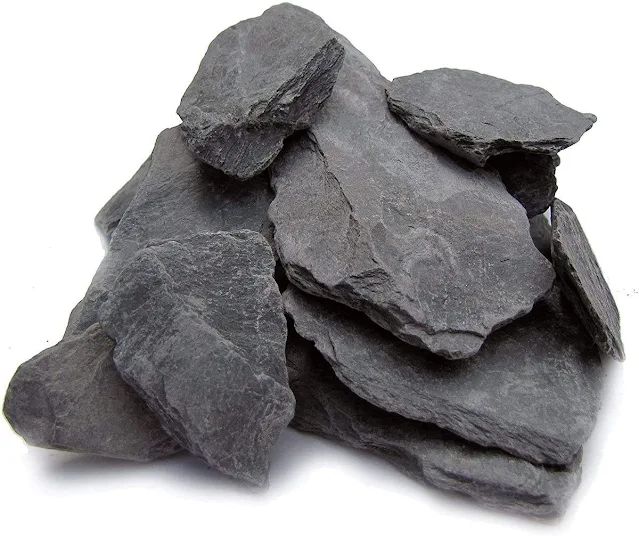 |
| Oil shale samples |
Shale Colors
Shale exhibits a diverse range of colors, reflecting variations in mineral composition, organic content, and diagenetic processes.
Gray Shale:
Gray is one of the most prevalent colors in shale formations. It often indicates the presence of minerals like illite, kaolinite, and smectite. Gray shale may also result from the mixing of various minerals with organic matter.
Black Shale:
Black shale is characterized by a dark color, which is primarily attributed to high organic content. The organic matter, often derived from marine organisms and plant debris, undergoes diagenetic processes, contributing to the dark hue. Black shales are particularly significant as source rocks for hydrocarbons.
Red Shale:
Red shale derives its color from the presence of iron oxide minerals, such as hematite or goethite. The oxidation of iron during diagenesis imparts a reddish tint to the rock. Red shale formations are commonly associated with terrestrial environments.
Green Shale:
Green shale owes its color to the presence of minerals like chlorite or glauconite. These minerals contain iron and magnesium, imparting a greenish hue to the rock. Green shales are often associated with marine environments.
Brown Shale:
Brown shale may result from the presence of iron minerals, organic matter, or alterations during diagenesis. The specific shade of brown can vary based on the concentration and type of minerals involved.
Yellow and Tan:
Shale formations may exhibit shades of yellow or tan, which can result from the presence of iron-bearing minerals such as limonite (hydrated iron oxide) or from the alteration of clay minerals under specific environmental conditions.
The color variations observed in shale formations provide valuable insights into past environmental conditions, sediment sources, diagenetic processes, and tectonic histories.
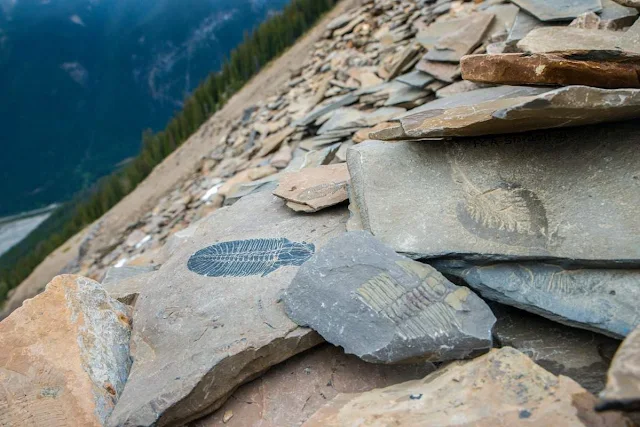 |
| Burgess Shale fossils |
Oil Shale
Oil shale is a fine-grained sedimentary rock distinguished by its abundance of organic matter, specifically a precursor to oil called kerogen, from which hydrocarbons can be extracted through a process known as pyrolysis. Unlike conventional shale, oil shale possesses a substantial amount of kerogen, a precursor to liquid hydrocarbons. This geological resource has garnered attention due to its potential as an unconventional source of oil. Unlike conventional shale, which is primarily composed of clay minerals and other inorganic sediments, oil shale holds the potential to be a valuable source of liquid hydrocarbons, similar to traditional petroleum.
Oil shales were formed from the sedimentation of organic material, primarily the remains of algae and aquatic microorganisms, in ancient lacustrine, marine, or terrestrial environments. These sediments underwent diagenetic processes, including bacterial activity and thermal maturation, that transformed the organic matter into kerogen.
Noteworthy deposits are found in sedimentary basins globally, with substantial reserves in regions like the Green River Formation in the United States, the Baltic Basin in Estonia, and the Irati Formation in Brazil.
Composition: Kerogen constitutes the bulk of the organic fraction in oil shale, typically ranging from 10% to 30% by weight. The remaining organic components include bitumens (soluble organic molecules) and other hydrocarbons. The inorganic matrix of oil shale comprises various minerals, most commonly clays, carbonates, and quartz.
The extraction of hydrocarbons from oil shale involves a thermal process called pyrolysis. During pyrolysis, the rock is heated to high temperatures, typically ranging from 450 to 500 degrees Celsius, triggering the decomposition of kerogen into oil, gas, and solid residues. This process requires careful engineering to optimize yields and minimize environmental impact.
Distinguishing oil shale from conventional shale lies in the substantial kerogen content of the former. While both types of shale are sedimentary rocks, conventional shale lacks the elevated levels of kerogen found in oil shale. Conventional shale primarily serves as a source rock for hydrocarbons, generating petroleum through natural geological processes, but its kerogen content is typically insufficient for economic extraction.
In summary, oil shale stands as a distinctive geological resource with a high kerogen content, making it a potential unconventional source of hydrocarbons.
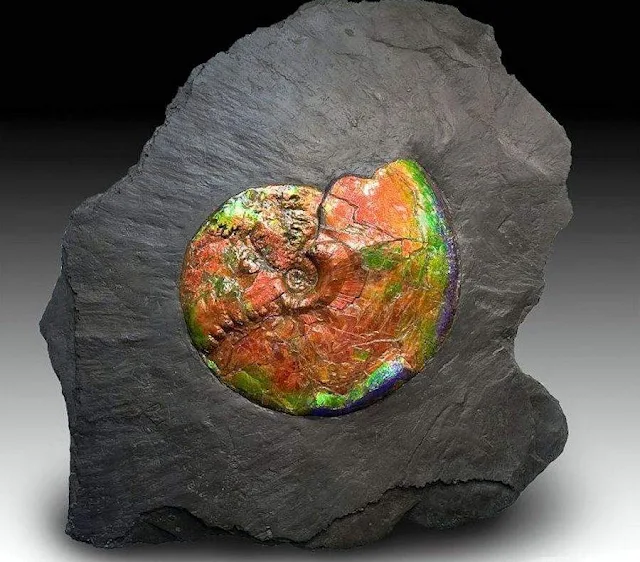 |
| 70 million year old ammolite fossil embedded in shale - Canada |
Shale Uses
Shale has several practical uses across various industries due to its unique properties. Some common uses of shale include:
Construction Material: Shale is used as a construction material in the production of bricks, tiles, and other building materials. Its fine-grained structure allows for the creation of durable and stable construction products.
Oil and Gas Extraction: Shale plays a crucial role in the oil and gas industry. Shale formations, especially those rich in organic matter, are targeted for oil and gas extraction through techniques like hydraulic fracturing (fracking).
Ceramics and Pottery: Shale is a significant raw material in the production of ceramics and pottery. When processed, shale can be used to create heat-resistant and sturdy ceramic products.
Cement Production: Shale is used in the production of cement. It is often combined with limestone and other materials to create clinker, a key component in cement manufacturing.
Landscaping and Paving: Crushed shale is used in landscaping and paving applications. It provides stability and durability to surfaces such as driveways and walkways.
Agricultural Soil Amendment: In some cases, shale is used in agriculture as a soil amendment. When finely ground, shale can contribute minerals and improve soil structure.
Road Construction: Shale is employed as a material in road construction. Its properties make it suitable for creating stable road surfaces.
Geotechnical Engineering: Shale's characteristics are considered in geotechnical engineering for assessing soil stability and slope stability. The presence of shale can influence the design and construction of civil engineering projects.
Water and Wastewater Treatment: Shale can be processed into granules or pellets for use as filter media in water and wastewater treatment applications.
Artificial Lightweight Aggregates: Shale can be expanded and processed to create lightweight aggregates used in construction. These aggregates are valued for their low density and insulating properties.
The versatile nature of shale makes it a valuable resource in various industries, ranging from traditional construction materials to advanced applications in the energy sector.
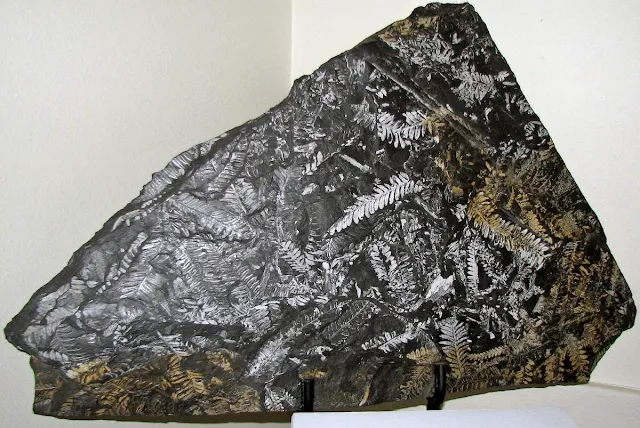 |
| Fossil plants in fossiliferous shale from Pottsville Formation, Middle Pennsylvanian; old coal mine ENE of St. Clair, Pennsylvania |
Famous Shale Formations
Several famous shale formations around the world have significant geological importance. Here are a few notable examples:
Burgess Shale (Canada)
Location: The Burgess Shale is situated in the Canadian Rockies, near Yoho National Park in British Columbia, Canada.
Geological Information: Dating back to the Middle Cambrian period (about 505 million years ago), the Burgess Shale is renowned for its exceptional preservation of soft-bodied fossils. The fossils provide valuable insights into the early evolution of complex life forms during the Cambrian Explosion.
Contributed significantly to understanding the early evolution of body plans and ecological relationships.
Green River Formation (United States)
Location: Extending across parts of Colorado, Wyoming, and Utah, the Green River Formation is a prominent shale formation in the western United States.
Geological Information: The Green River Formation is known for its oil shale deposits, primarily from the Eocene epoch (about 50 million years ago). It contains a substantial amount of kerogen, making it a potential source of unconventional oil.
Bakken Formation (United States and Canada)
Location: The Bakken Formation spans parts of North Dakota, Montana, and Saskatchewan and Manitoba provinces in Canada.
Geological Information: Dating from the Late Devonian to Early Mississippian periods (approximately 360 to 340 million years ago), the Bakken Formation is a significant shale formation rich in oil and natural gas. Advances in horizontal drilling and hydraulic fracturing have increased its accessibility for hydrocarbon extraction.
Fuling Shale (China)
Location: The Fuling Shale is situated in the Sichuan Basin in China.
Geological Information: The Fuling Shale is part of the Lower Silurian Longmaxi Formation and has gained attention for its substantial reserves of natural gas. It has become a key focus for shale gas exploration and development in China.
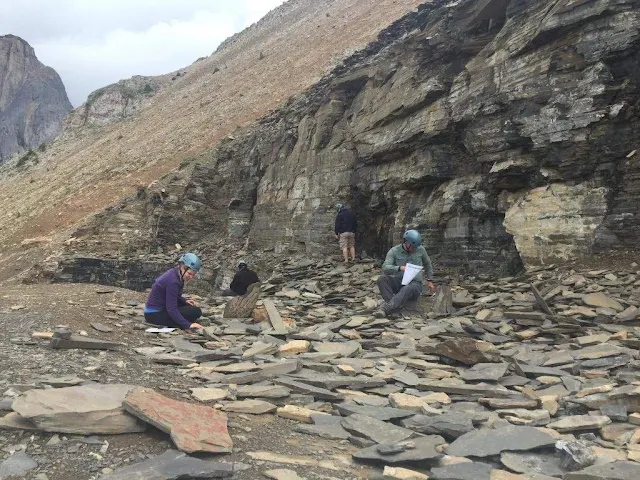 |
| Burgess shale |
Shale FAQs
Mudrock Vs Shale
Mudrock: A general term for any fine-grained sedimentary rock composed primarily of clay and silt particles. It encompasses several types, including shale, mudstone, claystone, and siltstone.
Shale: A specific type of mudrock characterized by its fissility, meaning it readily splits into thin, flat layers due to the alignment of clay minerals.
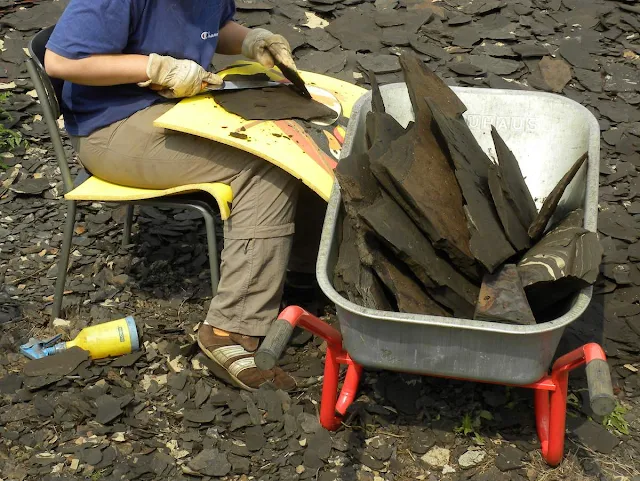 |
| Splitting shale with a large knife to reveal fossils |
Conclusion
Shale, a sedimentary rock formed over extensive geological timeframes, plays a crucial role in Earth's history and human activities. Its unique depositional environments, ranging from marine to lacustrine settings, contribute to the diverse characteristics observed in shale formations. The practical uses of shale, including energy production, construction materials, and environmental applications, highlight its significance in various industries.
References
- United States Geological Survey (USGS). (2023, June 15). Shale. https://www.usgs.gov/centers/central-energy-resources-science-center/science/oil-shale
- British Geological Survey (BGS). (n.d.). Shale. https://webapps.bgs.ac.uk/lexicon/lexicon.cfm?pub=BSG: https://webapps.bgs.ac.uk/lexicon/lexicon.cfm?pub=BSG
- Amini, M. H., Fazlpour, M., & Jalali, M. (2020). Shale: History, Rock Properties, and Modern Challenges. Minerals, 12(4), 44. https://www.mdpi.com/2079-9276/12/4/44: https://www.mdpi.com/2079-9276/12/4/44
- Schieber, J., & Katz, A. (2000). Sedimentology of Shale: Study Guide and Reference Source. Springer. https://link.springer.com/book/10.1007/978-1-4612-9981-3
- Geological Society of London. (2014). Shale Gas Subsurface Committee Report. https://www.energy.gov/articles/90-day-interim-report-shale-gas-production-secretary-energy-advisory-board
- Howarth, R. W. (2015). Environmental Impacts of Shale Gas Production. Annual Review of Environment and Resources, 40(1), 303-336.

%20(1).webp)






